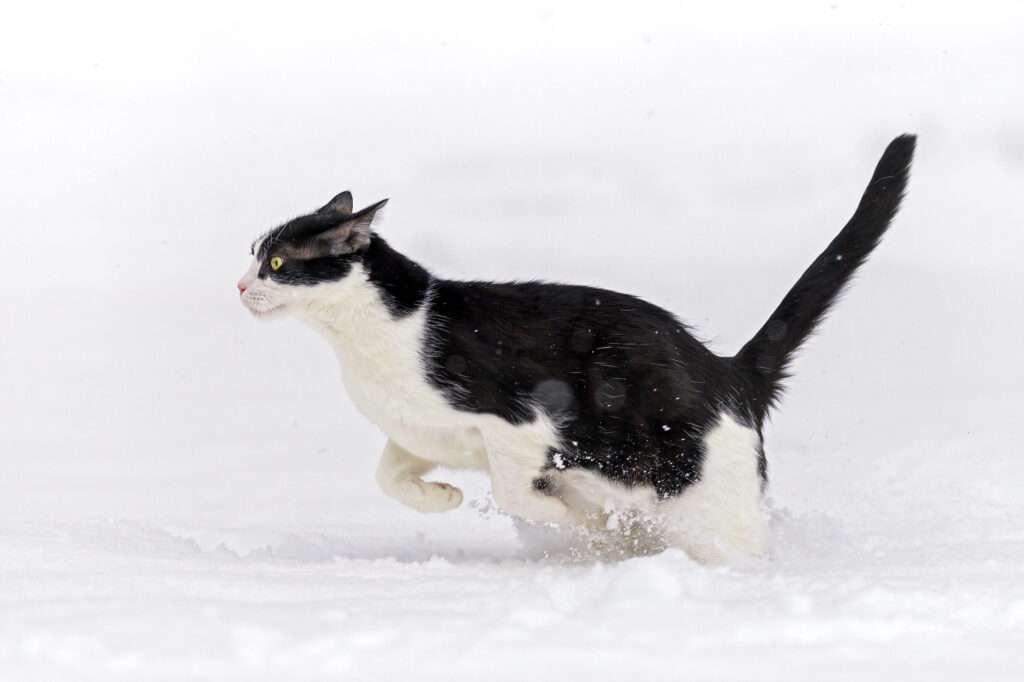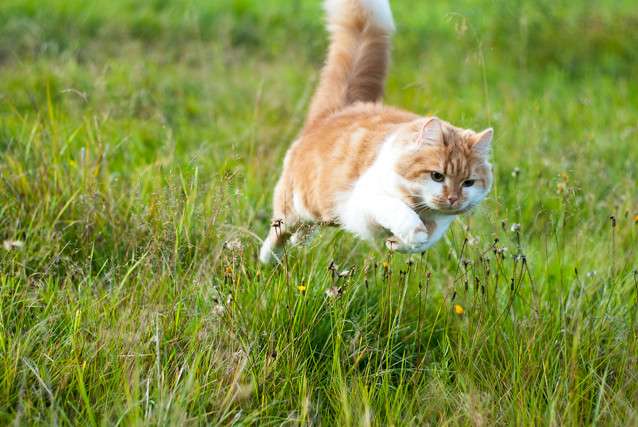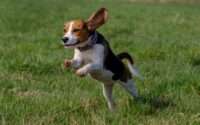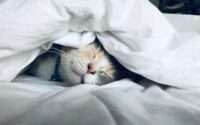How Fast Can a Cat Run? Discover the Astonishing Truth!
Cats are captivating creatures that have captured the affection of millions of people worldwide. As a cat owner, it is essential to comprehend your pet’s distinct characteristics, including their speed. So how fast can a cat run? The speed of cats is a question that many cat owners ponder, and the answer is more intricate than one may assume.
In this comprehensive guide, we will delve into the factors that affect a cat’s speed, the science behind their running abilities, and provide tips for measuring your feline’s speed. By the end of this article, you will gain a greater admiration for your cat’s remarkable abilities and be better equipped to care for them.
Understanding the Anatomy and Physiology of Cats

Cats are renowned for their remarkable agility and grace, but have you ever wondered what makes them such incredible sprinters? To uncover the secrets behind their lightning-fast speed, it’s essential to delve into the intricate world of feline anatomy and physiology. From powerful muscles to a flexible skeletal structure, every aspect of a cat’s physical makeup contributes to their impressive running abilities.
- Muscles: At the core of a cat’s ability to sprint lies its powerful muscles. Cats possess a lean and muscular body, with well-developed hind limbs that act as their primary propellers. These robust muscles generate the explosive force required for quick acceleration and high-speed dashes. As natural-born hunters, cats have evolved to rely on their agile bodies to chase down prey, and their muscles play a vital role in this pursuit.
- Flexibility and Skeletal Structure: A cat’s skeletal structure is another key component that enables its breathtaking speed. Unlike humans and many other animals, cats have an exceptionally flexible spine, allowing them to arch and extend their bodies with astonishing ease. This flexibility, coupled with an elongated torso and a specialized collarbone that acts as a free-floating structure, grants cats an impressive stride length and optimal range of motion.
- Eyes: Cats possess remarkable sensory adaptations that aid their lightning-fast sprints. Their eyes are designed with a horizontal slit-shaped pupil, which can dilate widely to capture as much light as possible. This adaptation enhances their vision, particularly in low-light conditions, allowing them to spot obstacles and navigate their surroundings swiftly.
- Ears: Furthermore, their keen sense of hearing plays a vital role in their speed. Cats have highly sensitive ears that can detect even the faintest rustle or movement. This acute auditory perception helps them anticipate prey movements, enabling lightning-quick reactions and precise direction changes while on the run.
Next time you witness your feline companion in action, take a moment to marvel at their incredible abilities, honed over thousands of years of evolution. Their mastery of speed and grace is a testament to their prowess as natural-born hunters and cherished members of our families.
Factors That Affect a Cat’s Speed
A cat’s speed is influenced by a variety of factors that can impact their agility and swiftness. Understanding these factors can help us appreciate the unique qualities that contribute to a cat’s individual speed and athleticism. From breed and age to weight and environment, each element plays a role in shaping a cat’s running abilities.
- Breed and Genetics: Just like humans, cats come in a delightful array of breeds, each with its own distinct characteristics. Some breeds are renowned for their exceptional speed and agility, while others may have different body structures that affect their running abilities. For example, breeds like the Siamese and Bengal are often celebrated for their lightning-fast sprints and nimble movements, thanks to their lean bodies and long limbs. On the other hand, breeds like the Persian may have a stockier build, which can impact their overall speed.
- Age and Energy Levels: Age is another crucial factor that influences a cat’s speed. Kittens are known for their boundless energy and lightning-quick dashes as they explore their surroundings with enthusiasm. As cats grow older, their energy levels may naturally decrease, leading to a more moderate pace. However, it’s important to note that individual cats may vary, and some older cats can still maintain impressive bursts of speed and agility.
- Weight and Fitness: Weight plays a significant role in a cat’s speed. Cats that are overweight may experience reduced agility and slower running speeds due to the added strain on their joints and muscles. Maintaining a healthy weight through a balanced diet and regular exercise is essential for a cat to optimize their speed and overall well-being. Regular playtime and engaging activities can help keep cats fit, ensuring they can showcase their full speed potential.
- Environment and Lifestyle: A cat’s environment and lifestyle can also influence their speed. Indoor cats, while enjoying the comfort and safety of their homes, may have fewer opportunities for rigorous exercise, leading to a more sedentary lifestyle. On the other hand, outdoor cats have ample space to explore, climb, and sprint, which can contribute to their overall agility and speed. However, it’s important to prioritize the safety of outdoor cats by providing appropriate supervision and minimizing potential risks.
When considering a cat’s speed, it’s crucial to remember that each cat is an individual with their own unique attributes and characteristics. Whether they are gracefully darting across the room or engaging in a playful chase, a cat’s speed is a reflection of their breed, age, weight, and lifestyle. By understanding these factors, we can better appreciate the distinct qualities that make each cat special and marvel at their incredible capabilities.
The Science of Cat Speed
The science behind a cat’s speed is an awe-inspiring subject that unveils the secrets of their remarkable agility and lightning-fast movements. By exploring the principles of physics, we can begin to understand the incredible feats that cats achieve in their pursuit of prey or during a playful sprint.
- Force, Momentum, and Acceleration: At the core of a cat’s speed lies the principles of force, momentum, and acceleration. Cats possess a unique gait and muscle structure that allows them to generate powerful propulsive forces. When a cat pushes off the ground with its hind limbs, it propels itself forward, utilizing the force exerted against the ground to gain momentum. This forward momentum is what enables cats to achieve impressive speeds in a short span of time.
- Bounding Phase: Cats employ a combination of bounding and galloping techniques to reach their top speeds. In the bounding phase, all four limbs leave the ground simultaneously, resulting in a graceful, bounding motion. This bounding stride allows cats to cover significant distances quickly, with each leap propelling them forward.
- Galloping Phase: During the galloping phase, cats transition into a more traditional running motion. The front and hind limbs alternate, creating a galloping rhythm that helps them maintain their speed and stability. This combination of bounding and galloping allows cats to navigate various terrains and swiftly change direction when needed.
- The Importance of Tails: A cat’s tail is not merely an adorable accessory; it serves a crucial purpose in their balance and maneuverability. Acting as a counterbalance, a cat’s tail plays a vital role in maintaining stability while running at high speeds and executing quick turns. The tail acts as a rudder, helping cats make precise adjustments to their trajectory and ensuring they stay on course even during rapid movements.
Understanding the scientific principles behind how cats run and achieve remarkable speeds can deepen our admiration for their physical capabilities. The physics behind their speed showcases the intricate and extraordinary abilities of these incredible creatures, reminding us of the wonders that lie within their agile bodies.
How Fast Can a Cat Run?

Although some cat breeds are recognized for their speed, the average domestic cat usually has a top speed of about 20 miles per hour. Nevertheless, this can vary based on factors such as the cat’s age, weight, and overall health.
Generally, younger and healthier cats will be faster and more active than older or overweight cats. It is important to keep in mind that cats are not typically bred for their speed, unlike dogs. Therefore, their individual characteristics can greatly affect their speed.
Provided below is a table of a cat’s top speed when compared within the cat family across the animal kingdom.
Cat Species Reported Top Speed (mph) Cheetah 70-75 Caracal 50 Lion 50 Serval 45 Jaguar 40-50 Cougar 40-50 Leopard 40-45 Margay 30-50 Ocelot 40 Lynx 40 Bobcat 30-35 Fishing Cat 30 Rusty-Spotted Cat 25 Domestic Cat 20
The Fastest Cat Breeds
If you are curious about which domestic cat breeds are the fastest, then you have come to the right place. According to the Guinness World Records, the Egyptian Mau is the fastest cat breed, with a top speed of up to 30 miles per hour. Other speedy breeds include the Abyssinian, Bengal, and Savannah. These breeds are known for their athleticism, agility, and energy, which make them excellent companions for active owners.
Provided below is a table of a cat’s top speed when compared among the different domesticated breeds.
| Cat Breed | Reported Top Speed (mph) |
|---|---|
| Egyptian Mau | 30 |
| Bengal | 25 |
| Savannah | 25 |
| Abyssinian | 20-25 |
| Siamese | 20 |
| Manx | 20 |
| Sphynx | 20 |
| American Shorthair | 19 |
| Persian | 18 |
| Maine Coon | 18 |
| Oriental Shorthair | 18 |
| Russian Blue | 18 |
| Devon Rex | 17 |
| Burmese | 16 |
| British Shorthair | 15 |
How to Measure Your Cat’s Speed
If you’re curious about your cat’s speed and want to embark on a thrilling adventure together, measuring their running pace can be an exciting endeavor. However, it’s essential to approach this activity with your cat’s safety and well-being in mind. Here are some valuable tips to ensure an enjoyable and responsible experience.
- Prioritize Your Cat’s Health and Comfort: Before measuring your cat’s speed, make sure they are in good health and ready to engage in physical activity. Ensure they are well-rested, hydrated, and not experiencing any discomfort or injuries that may impede their ability to run. It’s always a good idea to consult with your veterinarian if you have any concerns about your cat’s readiness for exercise.
- Choose a Safe and Open Space: Selecting the right location is crucial for measuring your cat’s speed accurately. Opt for a safe and open space, preferably outdoors, where your cat can have sufficient room to run without any obstructions. Ensure the surface is free from slippery or uneven areas that may pose a risk of injury. A grassy area or a secure and enclosed backyard can be an ideal setting for your cat’s speed assessment.
- Timing and Recording the Runs: To measure your cat’s speed, you can use a stopwatch or a camera with a timer function. When your cat is ready, start the timer as they begin to run and stop it when they reach the desired distance. Alternatively, you can record their run using a camera and review the footage later to determine the time it took. Remember to take multiple measurements to obtain an accurate average speed.
- Allow Rest and Recovery: It’s crucial to be mindful of your cat’s physical limits and not push them too hard. Give your cat breaks between runs to rest and recover their energy. Observe their behavior and ensure they are comfortable throughout the process. If your cat shows signs of fatigue or disinterest, it’s best to conclude the activity and allow them to rest.
Measuring your cat’s speed can be a fantastic opportunity to bond with your feline friend and gain a deeper understanding of their incredible abilities. Engaging in activities that pique their natural instincts and encourage physical exercise can contribute to their overall well-being. Remember to celebrate your cat’s achievements, regardless of the measured speed, as every cat is unique and special in their own way.
Conclusion
In conclusion, delving into the world of your cat’s speed can unlock a deeper appreciation for their incredible capabilities and aid you in providing the best care possible. By considering factors like breed, age, weight, and environment, you can gain insight into what influences their speed and tailor their activities accordingly.
While measuring your cat’s speed can be a fun and informative endeavor, always remember that their safety and well-being should be the top priority. Creating a safe and controlled environment for the measurement process ensures that your furry friend can enjoy the experience without any unnecessary risks.
Whether your cat zooms around like a cheetah or prefers a more leisurely pace, their unique personality and companionship bring immeasurable joy to your life. Understanding their speed and embracing their individuality allows you to create an enriching environment that caters to their specific needs.
So, cherish those zoomies, treasure the graceful bounds, and celebrate the moments of stillness. Your feline companion is an extraordinary creature, and by nurturing their well-being and fostering a deep bond, you’ll continue to create a lifetime of cherished memories together.
Frequently Asked Questions
What is the top speed that a cat can run?
Cats are known for their agility and speed. On average, a domestic cat can run at speeds of around 20 miles per hour (32 kilometers per hour). However, individual cats may vary in their speed capabilities.
Are certain cat breeds faster than others?
While all cats possess natural speed and agility, some breeds are known to be faster runners than others. For example, the Egyptian Mau and Abyssinian cat breeds are considered to be among the fastest cat breeds.
How does a cat’s running speed compare to other animals?
In terms of pure speed, domestic cats are faster than many other common household pets, such as dogs. However, they are not as fast as some of the fastest land animals like cheetahs, which can reach speeds of up to 75 miles per hour (121 kilometers per hour).
Can all cats run at the same speed?
Not all cats can reach the same top speeds. Factors such as breed, age, physical condition, and individual differences play a role in determining a cat’s running speed. Additionally, cats may have different levels of motivation to run at top speeds.
Do cats run at their maximum speed all the time?
Cats usually run at their maximum speeds when they are in pursuit of prey or engaged in play. However, in regular day-to-day activities, they often prefer to conserve their energy and may not run at top speed unless necessary.
How can I encourage my cat to exercise and run?
Providing interactive toys, engaging in play sessions, and creating an enriching environment with climbing structures and tunnels can motivate your cat to run and exercise. It’s important to make sure your cat has enough space and safe opportunities to engage in physical activity.
Are there any risks associated with cats running at high speeds?
While cats are naturally skilled runners, it’s important to ensure their safety. Running at high speeds can increase the risk of accidents, collisions, or injuries. Supervise your cat’s activities, especially when they are outdoors, to minimize potential hazards.





